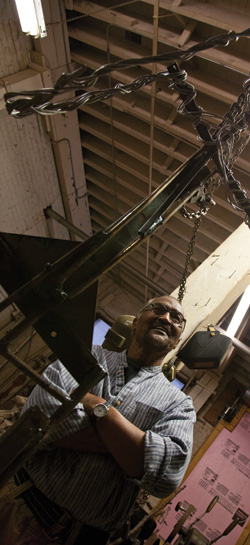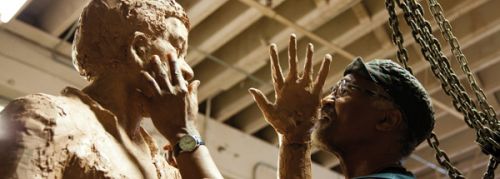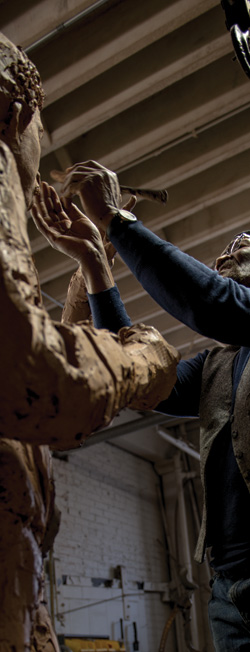Long overlooked by his hometown, he’s arguably the most famous Peorian of all.
“Peoria has long had a love-hate relationship with some of its icons,” read the Journal Star editorial marking the 50th anniversary of Betty Friedan’s groundbreaking book, The Feminine Mystique. “Friedan upset the apple cart and people understandably have strong opinions about that. But there can be no disputing her historical significance, her niche as a game-changer, for better and worse.”
Indeed, since its days as a “wide-open town”—steeped in whiskey, prostitution, gangsters and gambling—Peoria has struggled with how to recognize its more controversial sons and daughters. And few have been as controversial as the late Richard Pryor.
There’s no disputing his place at the pinnacle of his field. He’s been called “the Picasso of our profession” by none other than Jerry Seinfeld. Being on stage with Pryor, mused Robin Williams, was “like being able to play jazz with Coltrane.” From Bill Cosby and Bob Newhart to Louis C.K. and Chris Rock, you’d be hard-pressed to find a comedian who’s escaped his influence.
But Richard Pryor was no mere comedian. He employed his art tactically, ripping apart stereotypes and expounding on social issues in an unflinching manner that spared no sacred cows. Against all odds, he lifted himself out of poverty, achieving worldwide success and forever altering the ways we deal with race and class. His unusually personal art was a window into a vulnerable soul, as well as the endless struggle to extend dignity and equality to all.
Growing Pains
Richard Franklin Lennox Thomas Pryor III was born on December 1, 1940, in Peoria, Illinois, where he spent his first 21 years. His life story is well-documented, from his troubled childhood and mentorship at Carver Center by a devoted Juliette Whitaker, to international fame as a comedian and actor, to his long battle with multiple sclerosis. All throughout, the creative genius at the heart of his material has often been overshadowed by a tumultuous personal life from which it could not possibly be decoupled.
Ultimately, Richard Pryor’s complex legacy cannot be fully understood without reflecting on both the times in which he lived and the devastating pain of his childhood. Abandoned by his mother, a prostitute, he grew up quickly in his grandmother’s brothel, witnessing things no child should see, and suffered sexual abuse at the age of six. “Growing up was a minefield,” he declared in Pryor Convictions, his brilliant 1995 autobiography.
In this pre-civil rights era, he faced unconcealed racism on a daily basis. “Black people didn’t have it so good in Peoria,” he wrote. “Almost half the black people living in Peoria’s ghetto didn’t have any job whatsoever. Only two restaurants and two movie theaters in town served people of color, and if a black man wanted a hotel room for the night, he had to find it elsewhere.” No wonder the city and the man have had such a contentious relationship: because for him, in so many ways, Peoria was synonymous with pain.
Subsequently, Pryor’s unquenchable appetite for drugs and women was the direct product of an elusive search for happiness. “In the world in which I grew up, happiness was a moment rather than a state of being. It buzzed around, just out of reach… It never stayed long enough for you to get to know it good.”
That he was able to transform his pain into a body of work that continues to bring laughter and joy to millions is an astounding matter of social alchemy. Despite the demons he could never manage to keep in check, Pryor became the country’s definitive black entertainer—and after signing a $40-million contract with Columbia Pictures in 1983, its most highly paid as well. Few performers, before or since, have ever bared their lives so openly. “People can’t always handle it,” he wrote. “But I knew that if you tell the truth, it’s going to be funny.”

Midwestern Connections
Preston Eugene Jackson was born on March 1, 1944, in Decatur, Illinois, the same sleepy town where Richard Pryor’s father and paternal grandparents were born. Though some members of the two families knew one another, Jackson would not cross paths with Pryor until he hit the road with his band in the early ‘60s.
“My connection to Richard Pryor was when I was 18, 19 years old, traveling on the chitlin’ circuit,’” recalls the venerated artist and musician, painting a masterful picture of Harold’s Club, Collins Corner and the other primarily black nightclubs where his band, the Rhythm Aces, played gigs. “It was ‘black life’—everyone was plugged into each other… We walked everywhere; no one had cars. It was doo wop culture, street corners, walking ‘cool,’ wearing ‘Mr. B’ collars and tight, shiny suits. It was another world… colorful, but dangerous.’
“[Richard] would jump up on stage between acts… skinny dude. He’d get up there real fast and start talking before people could grab him. He moved quickly and got his piece in. He had something to say—and he would never rest.”
That restless energy would propel him to great heights. In 1963, Pryor set out for the bright lights of New York City, where he made his name in the clubs of Greenwich Village, performing alongside the likes of Bob Dylan and Woody Allen. Like every other African American—and an increasingly large white audience—Jackson followed Pryor’s career as it blossomed. By the mid-‘70s, he was a full-fledged superstar, with multiple records gone platinum, critically acclaimed roles in hit movies, an armful of Emmys and Grammys, and awards from the American Academy of Humor and Writers Guild of America. The “skinny little kid” from Collins Corner had made it.
Walking the Thin Line
In the early years, he mimicked Bill Cosby’s family-oriented act, but after an onstage epiphany in 1967, Richard Pryor found his authentic voice, and began to draw on the unique characters he remembered from his rough-and-tumble years in Peoria. “Real comedy wasn’t only tellin’ jokes,” he discovered. “It was about telling the truth. Talking about life. Makin’ light of the hard times.” Certainly, there was no shortage of material. It may not have been pretty, but his newfound direction was characterized by an unmistakable sense of humanity. As Cosby himself once remarked, “Richard Pryor drew the line between comedy and tragedy as thin as one could possibly paint it.”
“He stuck his neck out,” explains Jackson. “He came at us through comedy because… it’s an easy way to get your point across. And then, when the laughter ends, you think about it: Damn, was this supposed to be funny? This is real.”
Following in the footsteps of comedian Dick Gregory, Pryor’s use of the “N word” was among his most provocative stances. “One night I decided to make it my own,” he wrote. “Nigger. I decided to take the sting out of it. Nigger. As if saying it over and over again would numb me and everybody else to its wretchedness.”
He wasn’t the first to attempt to reclaim the word, but he was probably the most successful. “He tried to take the sting out of this offensive word,” says Jackson, “a word that not only destroys a people, but is injected into the psychology of a people.” Later, following a much-publicized 1979 trip to Africa, Pryor reconsidered this position, vowing never to use the word in his act again. Whether he was right or wrong, Jackson says, “We know deep down what he tried to do: to defang one of the most poisonous serpents in life—a word—and how diminishing and demeaning it could be.”
It’s a thread that connects Pryor to another “fearless observer of society, who outraged many while delighting and informing many more with his uncompromising perspective of social injustice and personal folly.” A century after his death, Mark Twain remains controversial for his use of the same word, despite his demonstrably anti-racist views, and usage that was both satirical and contextual—regional vernacular employed in the tradition of literary realism.
Fittingly, in 1998, Richard Pryor became the first recipient of the prestigious Mark Twain Prize for American Humor, awarded by the Kennedy Center for the Performing Arts. “He struck a chord… with America, forcing it to look at large social questions of race and the more tragicomic aspects of the human condition,” said Lawrence J. Wilker of the Kennedy Center upon presenting the award. “Though uncompromising in his wit, Pryor, like Twain, projects a generosity of spirit that unites us. They were both trenchant social critics who spoke the truth, however outrageous.”
“It is nice to be regarded on par with a great white man—now that’s funny!” Pryor joked in his acceptance speech. “Seriously, though, two things people throughout history have had in common are hatred and humor. I am proud that, like Mark Twain, I have been able to use humor to lessen people’s hatred.”

Universal Humanity
Having long aspired to sculpt the entertainer in bronze, Preston Jackson first got in touch with Jennifer Lee Pryor, his wife and caretaker, about a decade ago. Richard was still alive, but had long since receded from public view, debilitated by multiple sclerosis. “She caught the ball and ran with it,” he explains. “She was just as enthused as we were.”
After Pryor passed away in 2005, Jackson’s determination to bring this hometown tribute to fruition solidified. The African American Hall of Fame got involved, and a fund was set up through the Community Foundation of Central Illinois to accept tax-deductible donations. But after raising about $15,000, the project lost momentum, sunk by a sputtering economy and a host of other local projects competing for an ever smaller pool of dollars.
Last year, it was brought back to life at Jackson’s behest. “I have to do this,” he declared, his feelings so strong that he began work even as the funds were still being raised. “He normally wouldn’t do that,” explains his assistant, Joy Kessler. “But he believes in this, and he felt like it was never going to happen if he didn’t show people what it could be.”
The sculpture slides neatly into Jackson’s oeuvre, which is no stranger to racial and social themes, from the Underground Railroad Sculpture that hugs a wall of the Peoria Civic Center to his sprawling bronze-and-steel depictions of the Harlem Renaissance. “[Race] has affected my work,” he admits. “I can’t step out of my skin. No one can.”
But while Jackson hopes his art can open up minds, he’s a reluctant cultural warrior. “I look at my work, and I’m like, damn, have I ever been free to speak of anything other than social commentary and race crap? I’m tired of that… I don’t like the feeling of fighting racial issues all the time.” Having witnessed the endurance of this “poisonous serpent” even into the current day, however, he believes the fight remains.
More important to Jackson, and often overlooked, is that universal humanity coursing through Pryor’s work. “I’ve listened to his comedy over and over; I know everything he’s done. And I can sense the sincerity in his voice—the sincerity when he says, ‘You know, we’ve got to drop this race stuff’… That’s the real Richard Pryor, saying, ‘I don’t hate. I can’t hate…”
And his voice, Jackson says, was not confined to the black audience. “He [also] talked about the poorest white culture, and brought humor and beauty to it. They love their children just as much as anyone else,” he explains. “Now we’re talking about the economy and class: rich and poor. All of us are hurt by this [divisiveness].”
Jackson hopes to banish the stigma that has long surrounded attempts to recognize Richard Pryor in his hometown. But transcending the past begins by acknowledging the tough issues conjured up by his life and art, which is no easy task. Most of us prefer not to be reminded of the sins of the past, and yet, there they remain. The recipe for progress lies in recognition and acceptance; i.e., the cover-up is usually worse than the crime.
 Larger Than Life
Larger Than Life
Today, Richard Pryor looms larger than life in Preston Jackson’s studio at the Contemporary Art Center, a work in progress. Mic in hand, the clay figure stands in a soft, contrapposto stance, depicted at the height of his powers. An array of photographs lie scattered across a nearby workbench, allowing the sculptor to study his form from every direction, ensuring a highly original piece of work.
Mirroring Pryor’s complexities, the seven-foot statue also holds hidden truths. From one angle, the comedian’s raised left hand conceals his face, a position Jackson says is intentional. “That angle has a little bit of symbolism,” he explains mysteriously. “It’s like a mask. It says: ‘Not only a comedian.’ He’s somebody else, too.” It’s a brilliant touch, likening Pryor’s comedy to a shield, defending him from the suffering he could never forget.
As Jackson has shared images of his progress online, it’s whetted the appetites of Pryor enthusiasts, who’ve waited many years for such recognition. “The enthusiasm for this piece is overwhelming,” he claims. “When people come in here… you should see their faces, standing in my studio, looking up at the statue. They just break into narration, telling stories. You can see the pride.”
The statue is likely to capture international acclaim, drawing visitors from all over the world for years to come. Already well-established as Richard Pryor’s hometown, Peoria has historically been reluctant to claim him as its own, but the times are a-changin’. Some may never overcome their distaste for his language or lifestyle, but time has served Pryor’s legacy well—even if the same could not be said for all of his films. With some hindsight, context and perspective, the lasting significance of his life’s work is poised to finally outweigh the controversy.
For the Ages
We may not all appreciate his comedy or feel the same about his struggles, but it’s difficult not to hear the humanity in Richard Pryor’s voice—and see it in his eyes. At the macro level, he’s a symbol of the human condition in all of its flaws and beauty. As an individual, he represents the specific struggles of a specific human being at a specific point in time. His body of work is a priceless document of race relations in the post-civil rights era, his rags-to-riches tale an inspiration to many. He’s also funny as hell.
Meanwhile, around the world, his star continues to rise. In February, a retrospective of 18 Pryor films at BAMcinématek in Brooklyn honored “the beloved comedian and national treasure.” March brought the announcement that Oscar winner Forest Whitaker would team with Jennifer Lee Pryor to bring his story to the big screen—an effort that’s been in the works for nearly two decades. And in April, a feature-length documentary—described as “definitive” by the late comedian’s widow, also a co-producer—premiered at the Tribeca Film Festival. Featuring some footage shot last year in Peoria, it will be screened on Showtime later this year.
Here in Richard Pryor’s hometown, Preston Jackson plans to install his magnificent sculpture in a prominent downtown location, though some fundraising and legal issues remain to be worked out. “After I get the go-ahead, we can set the date,” he says. “We’ll work with the park district and the city on placement, and then it will go fast. I’m hoping for the fall.”
No matter what happens, the legacy of Richard Pryor will endure for the ages. While Peoria was once synonymous with his pain, we now have the ability to transform that pain into something far different. “[We] should tell Peoria’s transcendent story to the rest of the world without apology,” wrote the Journal Star. “And we should tell all sides of that story—good, bad and ugly—so that those who come from someplace else can better understand and appreciate us, and we better understand and appreciate ourselves.”
Back in his studio on the Peoria riverfront, Jackson is fired up and ready to go. “Let’s get it done.” a&s
Richard Pryor quotes taken from Pryor Convictions and Other Life Sentences, published by Pantheon Books, 1995.


